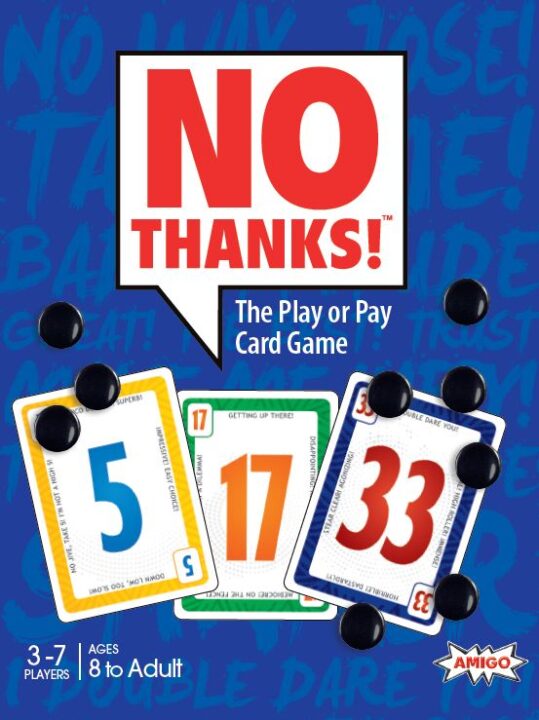How To Play: No Thanks! – Setup, rule summary and strategy
Become a 'No Thanks!' pro with our comprehensive strategy guide. From setting up your game to strategically managing your tokens, watching your opponents, and gaining insights into card values, we'll cover the essentials so you can dominate the next game night!

Overview
Welcome to the ultimate guide on ‘How To Play No Thanks!’ – not only will you find a concise outline of the game rules, but also an arsenal of the best strategies fine-tuned to tilt the scales of victory in your favor. Dive into the subtleties of token economy and card savvy that I’ve garnered through many engaging rounds with friends. It’s time to transform from a beginner to a No Thanks! champion.
What’s in the box
- 33 Cards numbered 3 to 35
- 55 Chips
- 1 Rulebook
How To Play No Thanks!: Rules Summary
Setting Up the Game
First, let’s get everything ready to play ‘How To Play No Thanks!’. Grab the 33 cards and randomly remove nine, keeping them unseen and separate from the game. Distribute 11 tokens to each player – these are your bargaining chips. Just like that, we’re set to start playing!
Gameplay Basics
The active player has a simple choice: play a token, or pick up a card. When a card is up for grabs, you can either say ‘No thanks!’ by placing a token on it or take the card along with any tokens already there. Subsequently, turns move clockwise.
Winning the Game
Here’s your ultimate goal: finish the game with the fewest points. Once the draw pile ends, tally up your score witnessed by relentless stares; cards count their face value while each token deducts one point. Remember, it’s a rarity in ‘No thanks!’ that having lower points is more desirable!
Special Rules & Conditions
- A sequence of consecutive cards only scores you points equal to the lowest one in the sequence.
- Gaps make collecting sequences riskier; avoid auctions on disconnected cards.
- Holding on to your chips gives you flexibility, but hoarding too many eats up your score.
- Refusing a card costs a token, but the next might be worse, bidding wisely is key.
- Donald’s Law of ‘No Thanks!’: you can pass every dilemma, but can’t escape them all.
Best No Thanks Strategies
Master Card Value Awareness to Win at No Thanks!
Understanding card values proves crucial in ‘No Thanks!’. Remember, high numbers can destroy your score, but when cleverly played, they sometimes offer strategic depth. Firstly, make mental notes of card patterns. Mid-game, deduce which cards were skipped. This aids in anticipating opponents’ next moves.
Card Assessment
- Analyzing each card’s risk versus its potential reward.
Skipping Strategically
- Knowledge of opponents’ stacks should inform your skip decisions.
Final Stretch Saves
- In the closing rounds, conserve tokens to avoid high-value penalties.
Masterful Token Management in ‘No Thanks!’
Understanding token management provides a cornerstone to your strategy in ‘No Thanks!’. Moreover, holding tokens equips you with the flexibility to avoid high-scoring cards. Firstly, consider how the game flows:
Mindful Spending
- Conserve tokens early to retain control over future decisions.
- Spend with caution; your stash influences your options.
Opportunist Collecting
- Grab low cards with excess chips; turn them into opportunities.
- Prefer collecting cards in a run to save tokens.
Stride the Edge
- Keep enough tokens to pass but not so many you miss scoring chances.
- It’s a delicate balance to hold just enough to keep your options open while dodging high points.
Ultimately, prudent token management makes or breaks the game. It’s not just about having tokens; it’s about using them shrewdly and to your advantage. And remember, sometimes the best move in ‘How To Play No Thanks!’ is knowing when to give a firm ‘No thanks!’ and when to take the plunge.
Mastering the Art of Predictive Play
Accurately interpreting opponent behavior turns the tide in ‘No Thanks!’. First, stay vigilant. Often, watch their token stash. Therefore, you can infer their next moves. Handling your tokens with foresight involves assessing others’ desperation. For example, whenever I notice someone’s low on tokens, I pass cards strategically, knowing they’ll be forced to take them.
Recognize Desperation
- Monitor token quantities contextually.
- Anticipate their forced plays.
Intercept Intentions
- Deduce card desirability based on previous actions.
- Counteract their strategy subtly.
Predict Pushback
- Expect resistance on high-value cards.
- Use this to your advantage.
Become a ‘No Thanks!’ Champion
And there you have it – a straight shot to victory. Adopt these guidelines, sharpen your discernment for card value, diligently manage those tokens, and size up your opponents like a chess grandmaster. During your next session of ‘How To Play No Thanks!’, watch as your friends marvel at your newfound strategic prowess. Remember, practice makes perfect, and with every game comes a precious opportunity to refine your approach, add a layer to your game, and edge ever closer to the coveted winner’s circle. Keep playing, keep learning, and may the best tactician win!
Want to know what we think of No Thanks!? Read our detailed review of No Thanks! here

